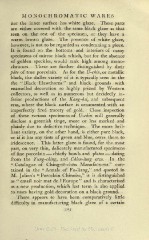Page 399 - Oriental Series Japan and China, Brinkly
P. 399
MONOCHROMATIC WARES
nor the inner surface has white glaze. These parts
are either covered with the same black glaze as that
seen on the rest of the specimen, or they have a
warm brown glaze. The presence of white glaze,
however, is not to be regarded as condemning a piece.
It is found on the bottoms and interiors of many
specimens of mirror black which, but for the absence
of golden speckles, would rank high among mono-
chromes. These are further distinguished by their
pate of true porcelain. As for the U-chin, or metallic
black, the duller variety of it is typically seen in the
the " " and black grounds with
Black Hawthorns
enamelled decoration so highly prized by Western
collectors, as well as in numerous but decidedly in-
ferior productions of the Kang-hsi, and subsequent
eras, where the black surface is ornamented with an
imperfectly fired tracery of gold. Close inspection
of these various specimens of U-chin will generally
disclose a greenish tinge, more or less marked and
plainly due to defective technique. The more bril-
liant variety, on the other hand, is either pure black,
or if it has any tints of green and blue, owes them to
iridescence. This latter glaze is found, for the most
part, on very thin, delicately manufactured specimens
of fine porcelain chiefly bowls and plates dating
from the Yung-ching, and Chien-lung eras. In the
" Manufactures "
Catalogue of Ching-te-chen con-
tained in the " Annals of Fu-liang," and quoted in
Julien's " Porcelain
M. Chinoise," it is distinguished
email noir mat de 1' is characterised
as " Europe " and
as a new production, which last term is also applied
to vases having gold decoration on a black ground.
There appears to have been comparatively little
difficulty in manufacturing black glaze of a certain

